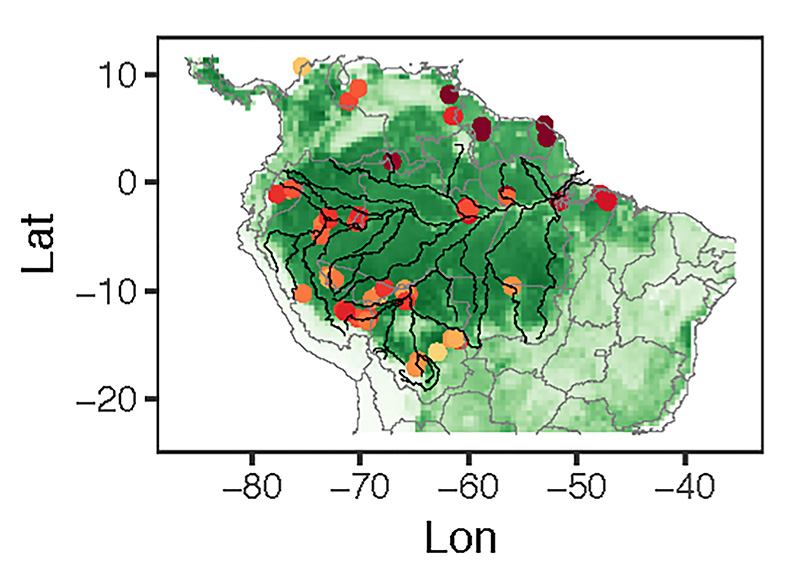Effects of Phosphorus Cycle Dynamics on Amazon Carbon Sources and Sinks
A Modeling Study Using E3SM's ELM v1

Figure 1. Map showing the Amazon study region and the locations of forest plots. Data from these observational sites were used to evaluate the model simulations. The reddish-colored dots represent the average of the measured aboveground biomass from the forest plots averaged to 0.5‐degree grid cell. Darker colored dots indicate higher aboveground biomass, lighter dots represent lower aboveground biomass.
Science
Tropical forests play a crucial role in the global carbon cycle, accounting for one third of the global net primary productivity and containing about 25% of global vegetation biomass and soil carbon. This is particularly true for tropical forests in the Amazon region, as these comprise approximately 50% of the world’s tropical forests. It is therefore important to understand and represent the processes that determine the fluxes and storage of carbon in these forests.
The Energy Exascale Earth System Model (E3SM) land model, ELM v1, is able to capture the observed west-to-east gradient of productivity and biomass in the Amazon because of the introduction of phosphorus (P) cycle dynamics and soil order-based tree mortality. P is generally considered as the most limiting nutrient in the old‐growth, lowland tropical forests, as most soil P has been lost through weathering and leaching during millions years of soil development. ELM v1 model simulations show that the consideration of P availability leads to a smaller carbon sink associated with the CO2 fertilization effect, and lower carbon emissions due to land use and land cover change (LULCC). The simulations suggest P limitation would significantly reduce the carbon sink associated with CO2 fertilization effects through the twenty-first century.
Impact
Recent climate models suggested that the Amazon carbon sink is resilient mainly due to the CO2 fertilization effect. A recently published study by E3SM scientists, however, suggests that the projected carbon sink would become much smaller when phosphorus limitation is considered. Combined with the possible decrease of the area of intact tropical forests that act currently as a carbon sink and increasing ecosystem respiration with climate change (due to increased microbe activity and plant respiration with warmer temperatures), the Amazon region may become a source of carbon in the future.
Summary
P cycle dynamics and carbon-nitrogen-phosphorus (C-N-P) interactions have been implemented in ELM v1, which allows ELM v1 to capture the observed spatial gradient of productivity across the Amazon region. Historical simulations suggest that the consideration of P availability leads to a smaller carbon sink associated with the CO2 fertilization effect, and lower carbon emissions due to land use and land cover change. When all environmental factors are considered, ELM v1 simulations show a smaller carbon sink in the Amazon region when P limitation is considered. The simulations with CO2 concentrations from the IPCC’s Representative Concentration Pathways 8.5 and 4.5 (RCP8.5 and RCP4.5) suggest that P limitation is critical for projecting future carbon uptake in tropical ecosystems. The predicted carbon sink in Amazon rainforests would be much smaller when P limitation is considered, suggesting that the Amazon tropical forests may offer less protection against future climate change than suggested by previous modeling studies.
Publication
Yang, X, D Ricciuto, P Thornton, X Shi, M Xu, F Hoffman, and R Norby. 2019. “The Effects of Phosphorus Cycle Dynamics on Carbon Sources and Sinks in the Amazon Region: A Modeling Study Using ELM v1.” Journal of Geophysical Research: Biogeosciences. https://doi.org/10.1029/2019jg005082.
Contact: Xiaojuan Yang, Oak Ridge National Lab



